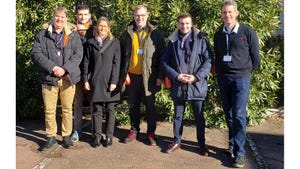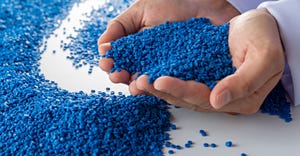IMM's Plant Tour: Precision molding, precision thinking
March 1, 2001
When the company name of Gaudlitz GmbH (Coburg, Germany) appears in its literature or on signs, it's always followed by the words "Precision in plastic," or in German, "Präzision in plastic." The message is clear in either language, and it is far more than a simple marketing statement. Precision was the core principle when Oskar Gaudlitz began to mold thermosets like Bakelite in 1937, and it remains the core of the business today. It is the key to this company's sustained growth.
This dedication to precision has resulted in a loyal base of customers that includes car and truck makers, lab equipment and testing device suppliers, communications manufacturers, and a variety of industrial equipment makers. Gaudlitz has spent more than 60 years earning its reputation for precision, and it does everything needed to maintain it.
Precise Molds
Perhaps the strongest evidence of the Gaudlitz dedication to precision is its unwavering commitment to moldmaking. Karl Gaudlitz, who entered the company at age 19 following his father's premature death, quickly realized that nothing was more critical than the mold for producing precise parts. Since 1949, the company has made all of its own molds, more than 12,000 in its history.
Gaudlitz General Manager Peter Schilling says the company knows there are other good moldmakers out there. What matters, though, is the quality of the service and products received by the customer, and Gaudlitz believes that having the toolmakers and molders within the same family is an advantage.
Of the 380 employees at Gaudlitz, almost 80 are moldmakers. Moldmaking equipment encompasses all the leading technologies, such as spark erosion, wire EDM, high-speed milling, laser welding, and more. During recent years, automation has been added as well. EDM machines with automatic tool changers can be loaded with many different components and left to run over the weekend. Most of the centers are equipped with a video camera so a moldmaker can check progress from remote locations using a portable computer.
On the design side, Gaudlitz went to CAD/CAM systems many years ago and with one exception has never looked back. The exception: It still generates drawings so details can be seen in large format by groups of people. Other than that, everything is kept in the digital domain from concept in I-deas to CNC programs in the machine room. These days, says Schilling, it is almost unheard of for a customer to arrive with anything but a CAD file.
The more complicated the mold, the more Gaudlitz wants to be sure it is made right. The molds Gaudlitz builds for other molders tend to be those that need wire EDM, chip grinding, or another advanced technology that Gaudlitz has and the other company does not. Virtually all molds are made from hardened steel, with hardening done by an outside specialist.
Gaudlitz invested more than DM 6 million ($2.9 million) in new buildings and DM 4 million ($1.9 million) in new machines and other equipment in 2000. With new space available for moldmaking, investment during 2001 will increase.
Did the company ever consider getting out of the moldmaking business to concentrate on molding? Never, says Peter Schilling. Control of projects and the ability to share knowledge between moldmakers and molders during development are invaluable benefits. When, as Schilling says, you add the absence of time- and money-wasting problems that occur when a mold is made elsewhere, Gaudlitz can be profitable while the customer gets a fair price.
Growth Prospects
When IMM visited Gaudlitz, it was completing two new expansions simultaneously, one for moldmaking and one for molding. Each is two levels tall. Another building is six levels. Like most molders, Gaudlitz wanted to build laterally, but when it was initially expanding the road plans around the property were unsettled. Needing space quickly, the molder built up. As a result, this is one of the few molding shops that has more square footage of production space than it has land. Larger molding machines are on the ground floor, smaller ones on floors above, assembly is above that, and then there is the school.
Gaudlitz had 120 molding machines before the current expansion and will have 140 when it's done. As before, these machines will all be in the range of 15 to 700 tons, and almost all will be robot equipped. The machines are from Arburg, Demag Ergotech, and Engel. Gaudlitz finds advantages in each manufacturer for different sizes and different applications. Gaudlitz recently began grouping its injection molding machines according to size for more efficient mold and part handling. The goal is to put a given mold on the same machine every time for consistency. It is expanding in the areas of multicomponent and insert molding.
VITAL STATS |
|---|
Gaudlitz GMBH, Coburg, Germany |
Square footage: |
Annual sales: |
Markets served: |
Parts produced: |
Raw material used: |
No. of employees: |
Shifts worked: |
Molding machines: |
Secondary operations: |
Internal moldmaking: |
Quality: |
Everyone who works at Gaudlitz is considered part of the quality department. |
The Five Ms
Philosophically, despite the fact that Gaudlitz became a shareholder company in 1992, it still has the "feel" of a family business. Service pins for 10, 15, or more years are worn prominently. Company successes and holidays are celebrated together. When IMM visited, employees were setting up tables in a newly finished molding space for a Christmas party. The machines would be installed the next day. A key to how Gaudlitz runs the business lies in a compact list of principles Schilling calls "The Five Ms."
The first M is Mensch, which in this case is best translated as "human beings." People, says Schilling, have always been and will always be the most important thing at Gaudlitz. Gaudlitz makes a strong effort to keep people motivated through information and training, and by just treating them as people. They know they are important and they have real responsibility.
Schilling's answer when asked how many people are in the quality department speaks volumes: 380, he says, which is everyone who works at Gaudlitz. The truth is, there are no quality inspectors at the firm. Quality checking is done by those making the product. Further, they all know that if a part costing one Deutsche mark fails, it can shut down a DM 200,000 medical device, and send a customer running.
The second M, Material, is the same in English and German. To Gaudlitz it means use the best that can be used and use it well, without waste. The next M, Methode, means do things the right way, organized and logically. It also means do things the Gaudlitz way, with precision in mind. Being methodical made it relatively easy for Gaudlitz to meet the qualifications for ISO 9001 and 14001 and QS 9000.
The fourth M is Maschine, which for Gaudlitz means having and knowledge to use the best technology available to meet customer needs. The fifth M, Mold, as noted above, is the heart of Gaudlitz.
Much of the material handling is done via a Colortronic system. This is supplemented by distributed drying due to the multilevel buildings and the wide variety of materials handled. | Gaudlitz's internal materials lab allows the company to constantly experiment with new materials, like the PAEK used in this 11-mm automotive part. |
|---|---|
A Gaudlitz specialty, gears like this helical POM unit are tolerance checked using coordinate measuring devices. | Finding that presses from different manufacturers offer advantages in varying sizes, Gaudlitz has three brands of injection machines: the smaller are Arburgs, medium are Demags, and larger are Engels. |
In-house School
The school where Gaudlitz trains molders and moldmakers is no casual affair. It is a dedicated facility occupying the top floor of the company's tallest building. There are classrooms and workbench areas. Gaudlitz is happy, says Schilling, to find people who have been to technical school previously, and their time in the internal program will be shorter by about a year. However, since Gaudlitz is selling technological competence at a very high level, the training has to be extensive.
Full training for molders is three years; for moldmakers, it's three and a half. Moldmaker trainees start without any CNC equipment, even though the Gaudlitz mold shop is virtually all CNC. Schilling says this is done so that they understand what the CNC machines are doing, and become moldmakers rather than programmers. Since the advent of the school in the early '50s, more than 600 people have passed through its program, most of them staying with the company.
This looks like a school because it is. Gaudlitz moldmakers and molding techs spend three or more years in this in-house training facility. | Programming high-speed machining centers to work on varying pieces, such as those shown here, overnight or through a weekend yields productivity that justifies Gaudlitz's continuing investment in new moldmaking machinery. Most machines have cameras that allow the operator to monitor production remotely using a PC. |
|---|---|
In the work area at Gaudlitz's in-house school for molders and moldmakers, initial work is done without CNC machines so that trainees learn how a mold is actually made. Then they learn how to do it with a computer. Training lasts approximately three years. | Complex molds are nothing unusual for Gaudlitz. This one is for the housing/handle unit of an atmospheric measuring device used after chemical spills and similar accidents. |
Future in Progress
Gaudlitz intends to continue doing what works for it: make great molds, use the latest molding technology, and provide a full range of downstream services, including assembly. And above all, be precise.
Despite a customer base of more than 280 active accounts, Gaudlitz continues to look for new customers at places like the Hannover Fair and the K Show. Some of the current accounts may simply not be growing, says Schilling, so it is necessary to look for others that are. This ties in with the molder's strategy of limiting any one market's share of the company's business.
Gaudlitz is supporting its customers as they globalize. A recently received order for a medical device is a good example. Initial design was done in the U.K., development took place in the U.S., and Gaudlitz is building the molds and making the parts to supply markets around the world. That, says Schilling, is when technology investments really pay off. Paying attention to the Five Ms, especially the first one, also pays. Excusing himself during his meeting with IMM, Schilling took a phone call. A recently retired engineering director of a good customer was calling to wish him Merry Christmas, one Mensch to another.
You May Also Like


